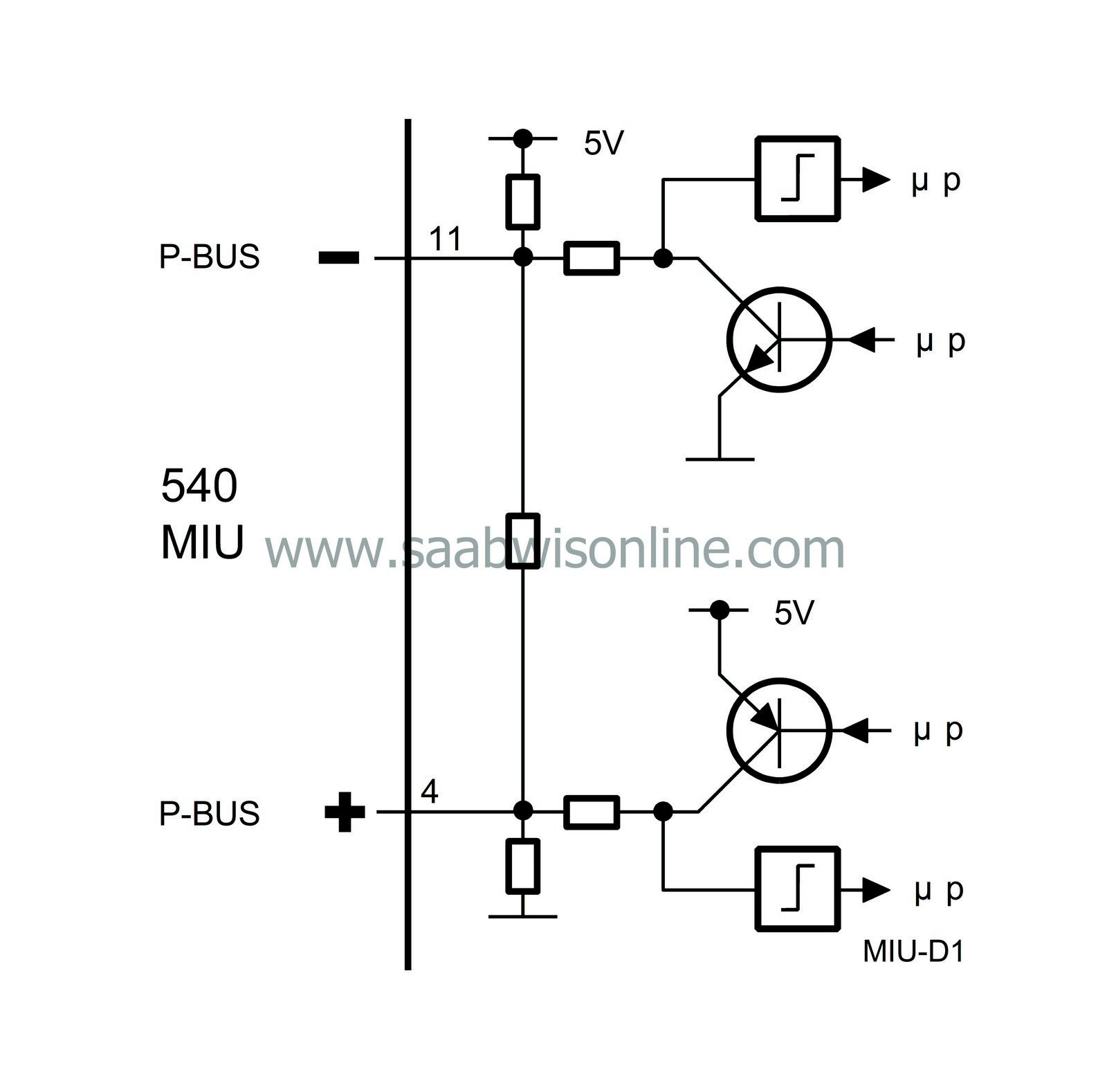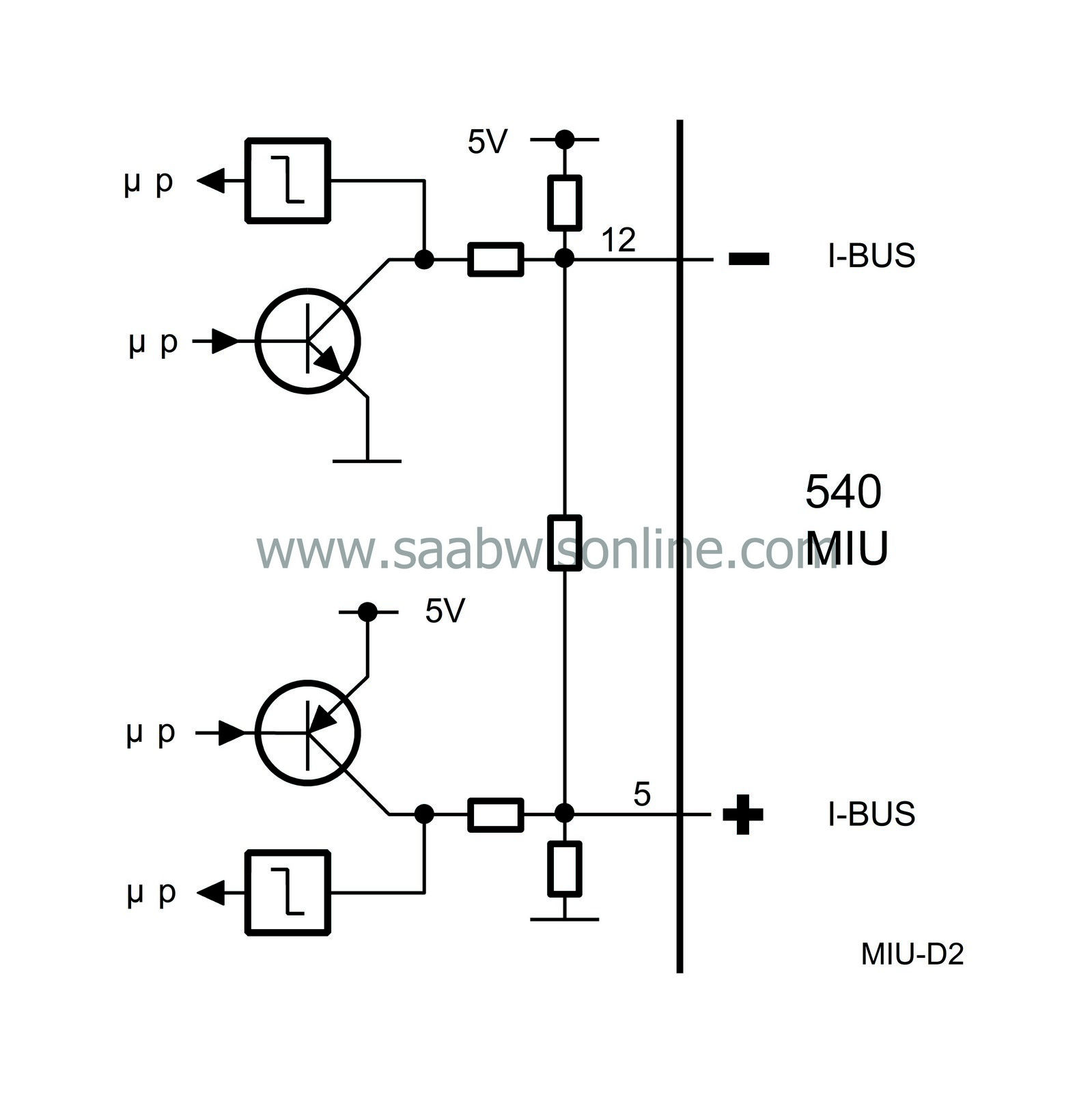Bus communication
| Bus communication |
| • |
Control module, ACC (216)
|
|
| • |
Radio connector C (267c)
|
|
| • |
Control module, Airbag/SRS (331)
|
|
| • |
Radio (353)
|
|
| • |
CD changer (355)
|
|
| • |
Control module, PSM (357Dk)
|
|
| • |
MIU (540c)
|
|
| • |
SID (541)
|
|
| • |
Control module, ABS (547)
|
|
| • |
Control module, STC (565)
|
|
| • |
Control module, EDC 15 (595)
|
|
| • |
Control module, auxiliary heater (597)
|
|
| • |
Diesel pump (598)
|
|
| • |
Control module, DICE (628)
|
|
| • |
Control module, TWICE (632)
|
|
| P-bus and I-bus |
A "bus" in this context means cables through which information is sent digitally and serially. By digital is meant that the voltage difference between the cables has only two values, approx. 0 and 5 V. The information is coded so that different combinations of pulses with the values 0 and 5 V denote different things.
Serial means that the information is sent in ”packets” which are transmitted one after the other in rapid succession.
The bus is divided into a Powertrain Bus (P-bus) and an Instrument Bus (I-bus). Both buses are connected to the Main Instrument Unit (MIU). The buses are electrically isolated from each other.
Only diesel cars and petrol cars with Trionic T7 have a P-bus. The other petrol engine variants have engine management systems and automatic transmission from the previous 900 models (T5, M2.10.3 and TCM), which are not bus-connected.
As in the 9-5, the Airbag and ABS control modules are not bus-connected.
The diagnostic tool is not connected directly to the bus but communicates via the DICE, one of the control modules connected to the I-bus, and so has access to all control modules connected to the bus.
The data transfer rate on the P-bus is ten times faster than on the I-bus. This is because the power train systems require information with as short a delay as possible.


All the information sent from one control module is accessible for all other control modules on the bus. The MIU is responsible for ensuring that information available on one bus is also available on the other bus.
The control modules send out information on the bus at regular intervals. The time between two transmissions depends on the information being sent and varies between 10 milliseconds (0.010 seconds) and 1 second. Information is also sent out by the control modules whenever the information changes.
The information is transferred between control modules via two leads, bus+ (green lead) and bus- (white lead). The leads are twisted to reduce their sensitivity to electrical interference.
| The MIU uses the following information: |
| Information | Values | From | The value depends on the following sensor input, signal or function |
|
LH direction indicators
|
ON/OFF
|
DICE
|
MIU turns on the indicator lamp for the LH direction indicators.
|
|
RH direction indicators
|
ON/OFF
|
DICE
|
MIU turns on the indicator lamp for the RH direction indicators.
|
|
Rear fog light
|
ON/OFF
|
DICE
|
MIU turns on the indicator lamp for the rear fog lights.
|
|
Driver's door
|
OPEN/CLOSED
|
TWICE
|
Door switch. The MIU lights the symbol for the driver's door.
|
|
Passenger door
|
OPEN/CLOSED
|
TWICE
|
Door switch. The MIU lights the symbol for the passenger's door.
|
|
LH rear door
|
OPEN/CLOSED
|
TWICE
|
Door switch. The MIU lights the symbol for the left rear door.
|
|
RH rear door
|
OPEN/CLOSED
|
TWICE
|
Door switch. The MIU lights the symbol for the right rear door.
|
|
Tailgate
|
OPEN/CLOSED
|
TWICE
|
Tailgate switch. The MIU lights the symbol for the tailgate.
|
|
Steering wheel location
|
LHD/RHD
|
TWICE
|
MIU turns on the indicator for the driver/passenger door
|
|
Info Disp Lamp
|
ON/OFF
|
SID
|
Text message. The MIU lights the Info Display indicator lamp.
|
|
Rheostat level
|
0-100 %
|
SID
|
Rheostat control module input. The main instrument unit controls the instrument lighting.
|
|
Rheostat Night Panel
|
0-100 %
|
SID
|
Rheostat control module input reduced internally by a fixed value.
|
|
Night Panel
|
ON/OFF
|
SID
|
Button. The MIU turns off certain instrument and display lighting.
|
|
Display lighting
|
0-100 %
|
SID
|
Rheostat control module input. The MIU uses this information to control the display lighting.
|
|
Light intensity in compartment
|
Lux
|
SID
|
Light sensor. The MIU uses this value to control the intensity of the indicator lamps.
|
|
CHECK ENGINE lamp
|
ON/OFF
|
EDC 15
|
Internal diagnostics. The MIU turns on the CHECK ENGINE lamp.
|
|
CRUISE Lamp
|
ON/OFF
|
EDC 15
|
Cruise control function. The MIU turns on the CRUISE lamp.
|
|
Fuel consumed since start
|
0-65535 ml
|
EDC 15
|
Fuel injection function. Used by the SID for the trip computer functions, can be adjusted by an offset on MIU.
|
|
Engine speed
|
0-6000 rpm
|
EDC 15
|
Crankshaft sensor. The MIU controls the tachometer.
|
|
Coolant temperature
|
-40-215ºC
|
EDC 15
|
Coolant temperature sensor. The MIU controls the coolant temperature gauge.
|
|
Glow indicator lamp
|
ON/OFF
|
EDC 15
|
Glow function. The glow indicator lamp lights during pre-heating.
|
| The MIU sends the following information: |
| Information | Values | Used by | The value depends on the following sensor input, signal or function |
|
Vehicle speed
|
km/h (mph)
|
EDC 15, DICE, SID, ACC, Audio, TWICE, STC
|
The main instrument unit calculates the current vehicle speed based on information on the wheel speed from the ABS control module.
|
|
Sound
|
Sound information
|
SID
|
Request for acoustical signal when central warning lamp or Info Displ goes on.
|
|
Fuel level
|
litres
|
SID
|
MIU sends information on the current fuel volume in the tank.
|
|
Odometer reading
|
km, miles
|
SID
|
Information on the driven distance.
|
|
Identification number
|
---
|
TWICE
|
Immobilizer function
|
|
Fuel consumed since start
|
ON/OFF
|
0-65535 ml
|
Bus from EDC15. The value is corrected with an adjustment factor in the MIU. The factor can be adjusted with the diagnostic tool.
|
|
STOP FOR FUEL
|
ON/OFF
|
SID
|
When the fuel level falls below 3 litres ON is sent. The MIU sends a text message to the SID, which shows it on the display.
|
|
Diagnostics communication
|
---
|
DICE/
Diagnostic tool |
DICE/diagnostic tool.
|



